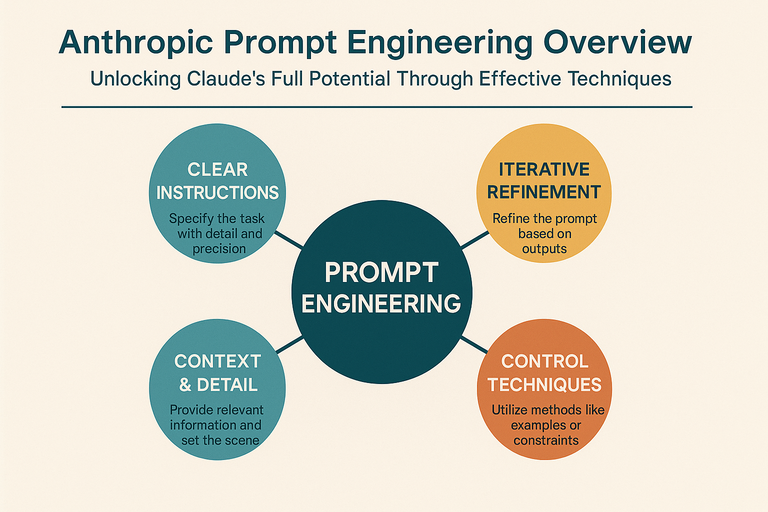Mastering Anthropic Prompt Engineering: A Comprehensive Guide to Unlocking Claude’s Full Potential
Estimated reading time: 10 minutes
Key Takeaways
- Focus on clarity and specificity in your prompts.
- Embrace iterative improvement through continuous refinement.
- Leverage available resources and tools provided by Anthropic.
- Stay informed about evolving best practices in prompt engineering.
- Test and document your findings systematically.
In the ever-evolving landscape of artificial intelligence, mastering prompt engineering has become a crucial skill for anyone working with large language models (LLMs). Today, we’re diving deep into Anthropic’s approach to prompt engineering, exploring how to maximize the capabilities of their renowned Claude AI models.
The Art and Science of Prompt Engineering
Anthropic, the innovative force behind the Claude model series, has established itself as a leader in AI research and development. At its core, prompt engineering is the sophisticated craft of designing and optimizing instructions or questions (prompts) for LLMs to generate the most accurate, reliable, and relevant outputs possible. Think of it as learning to speak the language of AI—the better your communication, the better the results.
The Crucial Role of Effective Prompting
Why is prompt engineering so important? Imagine trying to get directions from someone who speaks a different language—the clearer and more precise your communication, the more likely you are to reach your destination. Similarly, well-crafted prompts help avoid common pitfalls like hallucination (where AI generates false information), suboptimal answers, or irrelevant responses. For developers and users alike, mastering prompt engineering is the key to unlocking the full potential of AI models like Claude.
Core Concepts in Anthropic’s Approach
Success Criteria and Control
Anthropic emphasizes focusing on elements that can be directly influenced through prompt design. While not all challenges can be solved through prompting alone (some issues require model-level modifications), understanding what’s within your control is crucial for success.
Best Practices for Optimal Results
Anthropic’s latest guidelines for Claude 4 models (including Opus 4 and Sonnet 4) offer a treasure trove of best practices:
- Be Specific and Detailed
- Clearly state your intentions
- Provide comprehensive context
- Define expected outcomes
- Structure Your Prompts
- Break complex tasks into manageable chunks
- Organize information logically
- Use clear formatting when necessary
- Utilize Examples
- Demonstrate desired outputs through examples
- Include relevant context
- Show preferred formatting and style
Essential Techniques for Effective Prompting
- Direct Instructions
Start with clear, explicit commands like “Summarize this text in three bullet points” or “Explain this concept as if teaching a fifth-grader.”
- Step-by-Step Reasoning
Request detailed explanations by asking for specific steps in the reasoning process. This helps ensure thorough and logical responses.
- Role-Based Instructions
Leverage specific expertise by framing prompts through professional roles, such as “Act as an expert data scientist…”
- Few-Shot Prompting
Provide input-output examples to guide the model’s response style and format.
The Iterative Nature of Prompt Engineering
Success in prompt engineering isn’t about getting it right the first time—it’s about continuous refinement. Anthropic recommends:
- Regular Testing
- Try different variations of your prompts
- Document what works and what doesn’t
- Keep track of improvements
- Response Evaluation
- Assess output quality
- Check for accuracy and relevance
- Monitor consistency across multiple attempts
- Systematic Refinement
- Make incremental improvements
- Test changes systematically
- Document successful modifications
Practical Implementation with Claude 3 on Amazon Bedrock
For those working with Claude 3 through Amazon Bedrock, consider these practical steps:
- Initial Setup
- Begin with simple, well-defined prompts
- Utilize Amazon Bedrock’s playgrounds for testing
- Document your starting point
- Optimization Process
- Analyze responses systematically
- Refine prompts based on results
- Focus on clarity and structure
- Integration and Scaling
- Move successful prompts to production
- Monitor performance at scale
- Continue iterative improvements
Resources for Continued Learning
Anthropic provides extensive resources for mastering prompt engineering:
- Official Documentation
- Comprehensive guides
- Best practices documentation
- Technical specifications
- Interactive Learning
- Hands-on tutorials
- Practice scenarios
- Real-world examples
- Expert Insights
- Panel discussions
- Technical deep dives
- Evolution of prompt engineering practices
Looking to the Future
As AI technology continues to advance, prompt engineering practices will evolve. Staying updated with Anthropic’s latest guidelines and best practices is crucial for maintaining optimal performance with Claude models.
Key takeaways for successful prompt engineering include:
- Focus on clarity and specificity
- Embrace iterative improvement
- Leverage available resources and tools
- Stay informed about evolving best practices
- Test and document systematically
Conclusion
Mastering Anthropic prompt engineering is a journey of continuous learning and refinement. By following these guidelines and best practices, you’ll be well-equipped to harness the full potential of Claude and create more effective, reliable AI-powered applications. Remember, the key to success lies in clear communication, systematic testing, and ongoing optimization of your prompts.
Whether you’re a developer, researcher, or AI enthusiast, understanding and implementing these prompt engineering principles will help you achieve better results and unlock new possibilities in your AI applications. Keep experimenting, stay curious, and most importantly, keep refining your approach to prompt engineering.
Frequently Asked Questions
Q: Why is prompt engineering important when working with Claude models?
A: Prompt engineering is crucial because it enables you to craft instructions that help Claude models generate accurate and relevant responses. Effective prompts prevent issues like hallucinations and irrelevant outputs.
Q: What are some key strategies for effective prompt engineering?
A: Key strategies include being specific and detailed, structuring your prompts logically, utilizing examples, and engaging in iterative refinement through continuous testing and evaluation.
Q: How can I stay updated with the latest best practices in prompt engineering?
A: Stay informed by referring to Anthropic’s official documentation, participating in interactive learning opportunities, and following expert insights on the evolution of prompt engineering practices.
